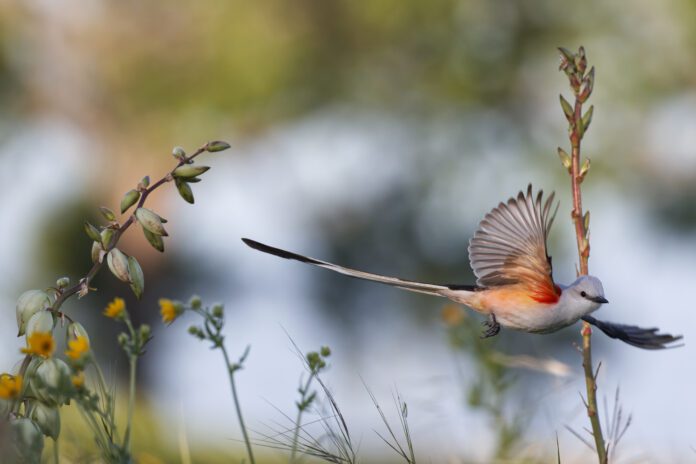Enjoying Oklahoma wildlife can be part of the overall experience of living in-state. With a few tips from local experts, or from doing a little research on your own, that experience can be greatly enhanced and keep everyone – and thing – as safe as possible.
“Oklahoma is a bit of a melting pot of habitats,” says Jena Donnell with the Oklahoma Department of Wildlife Conservation. “The state’s mix of forests, woodland, shrublands, grasslands and aquatic habitats allows an even broader mix of fish and wildlife to call Oklahoma home. While some species may be habitat specialists and are only found where that habitat occurs, others are generalists and can be found statewide or nearly statewide.”
Donnell points out the scissor-tailed flycatcher, Oklahoma’s state bird, is one such species.
“It migrates to Oklahoma in late March to early April and can be seen flying out to catch insects or sitting on fenceposts, tree branches and even tall flower stalks across the state through October,” explains Donnell. “Other birds, like the red-tailed hawk, Oklahoma’s state raptor, are found in Oklahoma year-round.”
According to Donnell, staying quiet and paying attention to one’s surroundings can increase the opportunity to have a ‘positive wildlife encounter.’ She suggests listening for sounds the animal may be making and watching for movement nearby.
Having a general idea of the wildlife you could encounter and how to interact with them is important, too.
“It’s exciting to get close enough to really appreciate the animal and maybe snap a photo, but it’s also important to not get too close and be a perceived threat,” stresses Donnell. “For coyotes, you’ll want to make noise to scare them off, but with bobcats, it’s best to be quiet and leave immediately.”
Donnell notes spotting the critters on or along our paths is frequently a two-way street.
“Most wildlife will detect us first and either hide or run or slither away before we even know they’re in the area,” she says. “But if we happen to surprise wildlife or they don’t have an easy escape route, it’s important to stay calm and slowly back away and give the animal enough space so that it feels less threatened. Once you’ve given it space, you can quietly watch it, take a few pictures, and then go around it and let it get on with its day.”
When children or dogs are part of your walkabout, Donnell offers the following guidelines.
“If you’re exploring with kids on a trail, it may be a good idea to station an adult at the front and rear of the group,” she says. “Keeping dogs on leashes can also help limit negative wildlife experiences.”
To entice wildlife to your yard, Donnell suggests choosing native plants that bloom at different times of the year, maintaining older trees or standing snags, and providing nest boxes or bird feeders.
“Living with the wildlife in your area requires balance,” says Donnell. “If you see wildlife more as pests than welcomed visitors, it’s time to think about what is attracting the animals and adjusting the habitat you’re offering. If those habitat changes don’t help, it may be time to call animal control or a nuisance wildlife control operator.”
Deterring Pests
• Secure your trash and trash bins.
• Feed your pets indoors.
• Keep your lawns trimmed and well-maintained.
• Rake leaves and remove debris from around house foundations to limit habitats for snakes and other wildlife.
• Install motion-activated lights to deter animals from making homes in your yard.
























